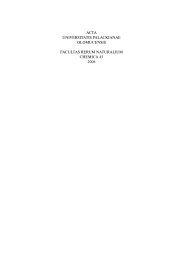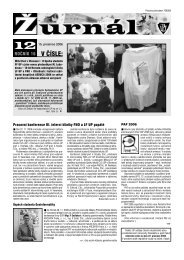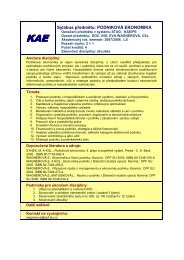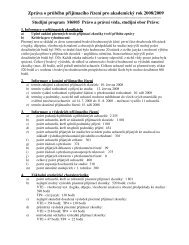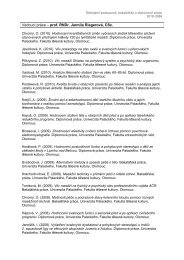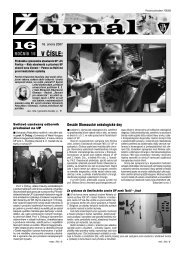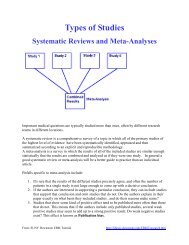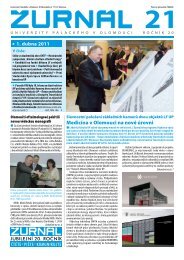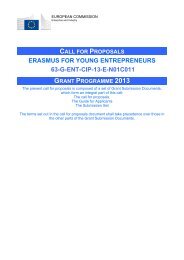ACTA UNIVERSITATIS PALACKIANAE OLOMUCENSIS GYMNICA ...
ACTA UNIVERSITATIS PALACKIANAE OLOMUCENSIS GYMNICA ...
ACTA UNIVERSITATIS PALACKIANAE OLOMUCENSIS GYMNICA ...
- No tags were found...
Create successful ePaper yourself
Turn your PDF publications into a flip-book with our unique Google optimized e-Paper software.
62 Acta Univ. Palacki. Olomuc., Gymn. 2004, vol. 34, no. 2Fig. 1a and 1bFiTRO Agility check for the assessment of multi choicereaction time of the lower extremitiesing performers (336.6 ± 17.4 ms), karate performers(339.4 ± 33.4 ms), ice hockey players (352.1 ± 28.9 ms),soccer players (364.0 ±33.8 ms), basketball players(369.3 ± 26.3 ms), volleyball players (370.6 ± 32.1 ms),and aikido performers (389.1 ± 38.4 ms) achieved asignifi cantly shorter reaction time in the agility testthan physical education students (398.8 ± 40.9 ms), judoperformers (400.3 ± 27.7 ms), and wrestlers (497.6 ± 20.9 ms)(Fig. 2). These results indicate that the test allows fordifferentiation of athletes with different performancelevels in agility skills.Talent identificationReaction and speed influence performance in manysports. However, these abilities considerably depend ongenetic dispositions and may be improved only by about15 to 25%. Therefore, information about the values ofreaction time in children of different ages is in sportpractice useful for talent identifi cation. On the otherhand, it has to be pointed out that the accuracy ofmeasurements of sensomotor parameters is influencedby many factors including motivation, incentive, attentiveness,etc., which are difficult to control in youngersubjects. Therefore, one has to be careful using thesevalues for selection of young sports talent.Such a cross-sectional study showed (Zemková& Hamar, 2001) that reaction time in the agility testwas 815.7 ± 100.9 ms for 7 and 8 year old children,649.6 ± 95.2 ms for 9 and 10 year olds, 604.9 ± 97.7 msfor 11 and 12 year olds, 467.5 ± 77.6 ms for 13 and 14year olds, 453.3 ± 38.6 ms for 14 and 15 year old youth,and 398.8 ± 40.9 ms for adults age from 20 to 26 yearsold (Fig. 3). This fi nding is in agreement with thereports of several authors (e.g. Thomas et al., 1981)who found that reaction time linearly decreased withincreased age up to early maturity.TABLE 1An example of the results of the agility testName: P. K. Date: 5. 5. 1998 Time: 16:21:34Test Setup: trial 1 Yellow Circle on Black BackgroundComment: hockeyMOVEMENT N BEST WORST AVERAGE SDDIRECTION (#) (ms) (ms) (ms) (ms)rear left 15 299 2092 661.4 582.3rear right 15 271 2017 561.1 433.4front left 15 309 1220 448.4 220.6front right 15 256 1340 522.3 345.2TOTAL 60 256 2092 548.3 423.8



